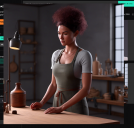Text to 3D or Text to Image?
Sooooo, I am confused. Originally this was advertised on the Tafi website as a Text to 3D tool. However, what is released is a Text to Image tool. Not sure/understanding if this is the same product or not. Never seen anything about this being anything but a Text to 3D tool. Would have completely set the industry aflame if they were able to use their library to generate fully rigged & typologized 3D figures with the creation of it being ChatGPT style. It would truly make them standout against the crowd and revolutionize the AI space.
If the text to 3D is a different tool, then that needs to be properly called out. As what is being presented is no better than Midjourney/Stable Diffusion (it's actually way worse). Seriously, the hands and eyes are wrong. Plus no inclusivity out the gate? Aaaaand you have to buy products you want to use AGAIN? Smh come on now. What's the deal here? Or am I missing something????






Comments
I am not sure if this a separate thing or part of the development work, but the text to 3D project has not been abandoned.
I was about to say, it would be nice if it could export a BOM of the Daz3D content which was use in the image.
You could use a discription of a character or scene, and come up with starting point, which you could then modify.
Is it possible that "text to 3D" is a misnomer that may lead to confusion?
If you look at the provided information:
source: https://maketafi.com/ai
Subjective interpretation of available information
- the users enter text to desribe a character
- with the help of metadata and tags the AI checks the runtime for available morphs, clothing, props and selects whatever matches the entered description
This is not the same as training AI to learn how to shape noise into 3D geometry based on a text prompt.
Alternative ways to phrase this could be:
How do you interpret the available information?
It's funny because OF COURSE I've been using TEXT to at least vaguely generate 2-D images of stuff that is "shaded" or rendered to look like there is light falling on it/it is being illuminated etc. in three dimensions.
But in anything related to DAZ Studio up until now, "text to 3-D" has to me meant "thick" letters like when you are making signs for use on the Las Vegas strip, or with appropriate "earthy" or "marble" surfaces something to do dinosaurs or Imperial Rome.